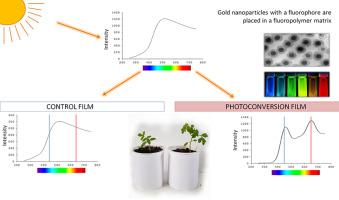Journal of Photochemistry and Photobiology B: Biology ( IF 3.9 ) Pub Date : 2020-10-18 , DOI: 10.1016/j.jphotobiol.2020.112056 Sergey V. Gudkov , Alexander V. Simakin , Nikolay F. Bunkin , Georgy A. Shafeev , Maxim E. Astashev , Alexey P. Glinushkin , Marina A. Grinberg , Vladimir A. Vodeneev

|
To convert and store energy in the process of photosynthesis, plants primarily use quanta of the red and blue parts of the spectrum. At high latitudes, the average daily intensity of red and blue parts of the spectrum is not very high; for many crops cultivated under greenhouse conditions, it reaches the sufficient level only on clear summer days. The problem of insufficient illumination in greenhouses is usually solved with artificial light sources. This article describes a technology for the manufacture of photoconversion fluoropolymer films for greenhouses. The fluoropolymer films described in the paper make use of original gold nanoparticles and nanoparticles with fluorescence in the blue or red region of the spectrum. In the polymer film, nanoparticles aggregate in the form of “beads”, which enhances the field of the optical wave. The film photoconverts UV and violet light into blue and red light. Gold nanoparticles also partially convert energy in the green region of the spectrum (not used by plants) into heat, which is also important for agriculture at high latitudes. In addition, impregnation of gold nanoparticles into fluoropolymer significantly increases the lifetime of the film. The films described in the paper can significantly increase the productivity of greenhouses located at high latitudes. Plants cultivated under the films have more chlorophyll and a higher intensity of photosynthesis – although their system of distance stress signals is, to a certain degree, suppressed.
中文翻译:

用于高纬或极纬温室的光转换含氟聚合物薄膜的开发和应用
为了在光合作用过程中转换和存储能量,植物主要使用光谱中红色和蓝色部分的量子。在高纬度地区,光谱中红色和蓝色部分的平均日强度不是很高;对于许多在温室条件下种植的农作物,只有在晴朗的夏日才能达到足够的水平。通常用人造光源解决温室中照明不足的问题。本文介绍了一种用于温室的光转换含氟聚合物薄膜的制造技术。本文中描述的含氟聚合物薄膜利用了原始的金纳米颗粒和在光谱的蓝色或红色区域具有荧光的纳米颗粒。在聚合物薄膜中,纳米粒子以“珠子”的形式聚集,从而增强了光波的场强。胶片将紫外线和紫光转换为蓝光和红光。金纳米粒子还将光谱绿色区域(植物未使用)中的能量部分转化为热量,这对于高纬度农业也很重要。另外,将金纳米颗粒浸渍到含氟聚合物中显着增加了膜的寿命。本文所述的薄膜可以显着提高高纬度温室的生产力。在膜下种植的植物具有更多的叶绿素和更高的光合作用强度,尽管它们的远距离胁迫信号系统在一定程度上受到抑制。这对于高纬度农业也很重要。另外,将金纳米颗粒浸渍到含氟聚合物中显着增加了膜的寿命。本文所述的薄膜可以显着提高高纬度温室的生产力。在膜下种植的植物具有更多的叶绿素和更高的光合作用强度,尽管它们的远距离胁迫信号系统在一定程度上受到抑制。这对于高纬度农业也很重要。另外,将金纳米颗粒浸渍到含氟聚合物中显着增加了膜的寿命。本文所述的薄膜可以显着提高高纬度温室的生产力。在膜下种植的植物具有更多的叶绿素和更高的光合作用强度,尽管它们的远距离胁迫信号系统在一定程度上受到抑制。











































 京公网安备 11010802027423号
京公网安备 11010802027423号